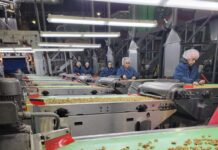
A mature walnut orchard in July can be a pretty quiet and hopeful place. Healthy trees are soaking up sunlight, water and nutrients to produce a quality crop of nuts.
Anticipating a good harvest in the weeks ahead, growers are paying attention to pest and disease levels in their orchards, aware that their stewardship this month can have an effect on the quality of their crop.
While there are important horticultural considerations in their crop in the month of July, walnut growers are also experiencing ongoing economic challenges. Pairing crop considerations with economic concerns requires some tough decisions and trade-offs.
Providing insight from a grower perspective is Davin Norene, a California Walnut Commission member and third-generation walnut grower. Sharing her observations and experience in Tulare County walnut production is UCCE Tulare County Farm Advisor Elizabeth Fichtner.
Five things growers would like to see in their walnut orchard in July:
1. Growing, Healthy Shoots
Norene said while he is watching the maturity of the current crop of walnuts and managing to achieve the highest quality, he knows next year’s crop is already developing.
“I want to see new growth in the orchard canopy and I try to manage a canopy that continuously develops new fruiting wood. If your canopy isn’t growing, then your trees and your yields are shrinking.”
Fichtner said healthy elongation of neo–form (in-season) growth in developing orchards is an indication of good irrigation management. If the orchard is overwatered, these shoots can become chlorotic and stunted.
Orchard conditions in mid-summer not only indicate how well water and nutrition are being managed in the current season, but effects of last year’s management can be evident. Healthy shoots and fruiting buds and the absence of blight mean next year’s crop is off to a good start.
2. Good Irrigation and Water Penetration
Norene said that during the dog days of summer, the soil in an orchard can seal up and prevent good water infiltration. To maintain good water penetration down into the root zone, Norene said maintenance applications of calcium or gypsum can help open up the soil.
Standing water in an orchard is an inefficient use of irrigation water and can also contribute to unhealthy environmental conditions for trees. Slow water penetration can cause mid-season depletion of deep soil water. Ponding on orchard floors causes aeration problems for the trees and prevents orchard access. The orchard may experience reduced vegetative growth and yields. There can also be higher incidences of root disease or nutritional problems resulting from poor soil aeration.
Prevention of soil crusting includes application of soil amendments, soil organic matter management and improved irrigation management.
3. Clean, Well-Placed Walnut Husk Fly (WHF) Traps
Norene said he wants to make sure his WHF lures and traps in the orchard are clean and effective. He also wants to be sure the traps are placed in the tree where they will catch WHF. Knowing orchard history is key to good trap placement. Increasing trap density should be done in the absence of orchard history as WHF infestations can be very localized.
UCCE recommendations for WHF trap placement is high in the canopy on the north side of the tree to gather good information for treatment decisions. A well-timed spray application will provide about three weeks of protection.
Finding very few uninfested nuts is a sign that a grower’s integrated pest management program is working, Fichtner said. Checking for spider mites and their predators, sixspotted thrips, through August is advised. Allowing low populations of spider mites in the orchard and avoiding broad-spectrum insecticides will help beneficial insect populations to increase and control insect pests, saving costs of spray applications.
Walnut aphid and two spotted mite are two insect pests that can cause tree stress and affect nut quality.
4. Good Leaf Sample Analysis
A leaf sample analysis taken mid-summer can reveal need for any corrective or supplemental nutrient applications pre-harvest. Norene said that as he begins to develop his fall and spring nutrient budgets and information from the samples help him make those decisions.
Samples help growers check on the effectiveness of nitrogen management programs as well as potentially monitor for deficiencies in potassium and zinc and toxicities in chloride and boron, depending on site and orchard history.
For a representative sample, take four terminal leaflets from at least 29 trees, each at least 100 feet apart, on the same rootstock, scattered throughout the orchard.
5. A High-Quality Crop!
This goes without saying, but a lot of factors must come together for an evenly mature, high-quality crop and an orchard achieving yield potential.
Fichtner said that for a good nut set, a healthy bloom can get the potential crop off to a good start. Good weather and overlap of female flower bloom and pollen shed are two factors in setting a crop.
Fichtner said an extended bloom, which was experienced in some walnut growing regions this spring, can lead to uneven nut maturity. Cool temperatures during ‘Chandler’ bloom in April resulted in an extended bloom period. As a result, flowers that had matured early gave rise to large nuts. Flowers maturing later gave rise to smaller nuts. Even after bloom has passed, this difference in nut maturity is evident even on the same tree. The difference in maturity will be realized at harvest as not all nuts will be shaken off the tree.











